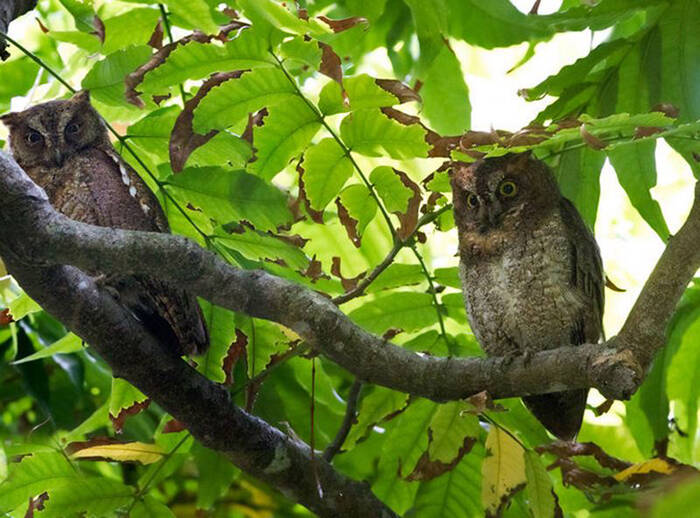Otus elegan
IUCN
LCBasic Information
Scientific classification
- name:Otus elegan
- Scientific Name:Otus elegan,Ryukyu Scops-owl,Elegant Scops-Owl,Okinawa Scops Owl, Ryukyu Scops Owl
- Outline:Raptor
- Family:Strigiformes Owl
Vital signs
- length:20cm
- Weight:About 150g
- lifetime:About 10-15 years
Feature
The wings have different shapes, and the fifth secondary flight feather is missing.
Distribution and Habitat
Distributed in Japan, the Philippines and Taiwan Province of China. Including Okinawa Island in southern Japan, Lanyu Island in southeastern Taiwan, China, and the Batanes and Babuyan Islands in the north of Luzon Island in the Philippines.
It lives in dense evergreen broad-leaved forests and mixed forests in low mountains. It especially likes mature forests with huge old trees, but it will also forage outside the forest. It also appears in gardens and orchards.
Appearance
The body length is 200 mm, the wing length is 164-173 mm, and the tail is 75-87.5 mm. Eyes and eyebrow lines are yellowish-white, the face plate is inconspicuous, yellowish-brown, mixed with gray and black feathers; the edge of the face plate is dark brown; the ear tufts are short and thin, reddish brown; the top of the head to the upper body is auburn, with dark brown beetles. Markings, thin black markings and yellow-white spots; reddish-brown spots on the shoulders, white spots on the outside of the primary flight feathers, light yellowish-brown from the front neck to the chest, with inconspicuous dark longitudinal spots, insect-like spots and gray-white spots; There is an obvious dark brown band on the upper chest; the lower chest and abdomen are yellow with dark brown horizontal spots and feather shaft lines; the lower abdomen is whiter without light reddish brown, and the tarsometatarsal feathers are cinnamon color with dark horizontal stripes.
The iris is yellow, the mouth is
Details
The elegant scops-owl, also known as the Ryukyu Scops-owl, is a nocturnal bird of prey with four subspecies.

The difference between the elegant scops-owl and the collared scops-owl is that the eyes are yellow and there is no collar; the difference between the elegant scops-owl and the yellow-billed scops-owl is that the bill is darker.
The call of the elegant horned owl: multi-voice. The call is a hoarse cough "uhu" or "kuru". Playing its recording or imitating its call can lead to this bird. The call is repeated 15-30 times per minute.
The breeding season of the elegant horned owl is between May and June. Nests in coconut trees and other natural tree holes. Each nest lays 2-3 eggs, the female incubates the eggs, and the male is responsible for carrying food for the female. The chicks are late-maturing, and are raised by both the male and female parents after hatching. The chicks will leave the nest after about 32 days, and the chicks will continue to be fed by the parents for more than half a month after leaving the nest.
The global population size of the elegant horned owl has not been quantified, but the species is described as common in the Ryukyu Islands. The total population on Lanyu is estimated to be 150-230 individuals (Konig et al., 1999), while the population size in other countries is estimated to be about 100-100,000 breeding pairs in Taiwan, China, and about 10,000-100,000 breeding pairs in Japan (2009). Trend reason: The number is suspected to be slowly declining due to continued but limited habitat loss and degradation.
Listed in the "Red List of Threatened Species of the World Conservation Union" (IUCN) 2017 ver3.1-Near Threatened (NT).
Listed in the second level of China's "National Key Protected Wildlife List" (February 5, 2021).
Protect wildlife and eliminate game.
Maintaining ecological balance is everyone's responsibility!








